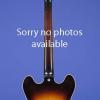A Fine 1967 330/12 with a Highly Figured Fretboard
This 15-inch-wide thin-body (1 1/2 inches deep) full-size twelve string guitar weighs just 7.30 lbs. and has a nut width of 1 5/8 inches and a scale length of 24 3/4 inches. Unbound hollow maple body with a "cat's-eye" or slash soundhole, three-piece maple/walnut/maple neck, and a highly figured rosewood fretboard with 21 frets and white dot position markers. Five-piece (maple/walnut/maple/walnut/maple) slotted headstock with white opaque plastic logo plate with black lettering. Twelve individual dual-line Kluson Deluxe tuners with oval metal buttons. Two Rickenbacker chrome bar "toaster" pickups with chrome covers and outputs of 7.34k and 8.60k. Two-piece split-level white plastic pickguard with four screws. Five controls (two volume, two tone, and one blend control) plus three-way pickup selector switch, all on lower level of pickguard. Seven-sided black plastic knobs with metal tops with black lettering. The potentiometers are stamped "137 6640" and "137 6708" (CTS October 1966 and February 1967). Rickenbacker bridge and Rickenbacker "R" tailpiece. The serial number "GG 3307" (July 1967) is stamped onto the jack plate. This beautiful guitar has a hint of "birds-eye" in the maple top, a most unusual highly figured fretboard, and is in exceptionally fine (9.00) condition, with only a few tiny insignificant surface marks and a minuscule amount of belt buckle scarring on the back of the guitar. Housed in its original Rickenbacker silver hardshell case with blue plush lining (9.00).
Production figures for 1967 are not available, but it is known that one single (the first) 330/12 in Fireglo (with "toaster" pickups) was shipped in late 1964, followed by 12 in 1965, 275 in 1966, and then the final nine in 1968.
"Probably no one single guitar typifies mid 1960s rock music better than the Rickenbacker electric twelve string. During that period, major groups like the Beatles, Beach Boys, Jefferson Airplane, and Byrds used Rickenbackers on countless recordings. The twelve string's brilliant tone was the basis for folk rock. The resurgence of a sixties style sound in the late 1970s and the popularity of artists such as Tom Petty brought it back. Far from being obsolete, the Rick twelve string was a potent tool for the 1980s musician...The idea for electric twelve strings was not new when Rickenbacker put the 360/12 on the drawing board in early 1963. A small company from Springfield, Missouri had made electric twelve strings called Stratosperes in the 1950s. The Stratospheres usually came setup for alternative tunings -- the player had to learn new scales and cord fingerings. The new tunings were an innovative idea, but not accepted. Gibson had made electric twelve strings with the regular tuning before Rickenbacker, but these Gibons were not popular...The first Rickenbacker twelve string had a conventional setup. By the end of 1963, Mr. Hall devised a novel way to make his new guitar easier to play and to make it sound more distinctive: he intentionally reversed the traditional twelve string stringing. On the new stringing, the twelfth string was the low E instead of the octave above the low E. The eleventh string was the octave string, etc. Strumming down, the lower pitch string was hit before its octave counterpart. George Harrison's double-bound 360/12 was the first Rick strung in this manner. (This is why Mr. Hall always calls George's the first RIckenbacker twelve string.) The Beatles gave the twelve string great exposure on records and in the movie A Hard Day's Night. Because of the increased demand created by the Beatles for the instruments, they became regular production items in 1964" (Richard R. Smith, The History of Rickenbacker Guitars, p. 190).
"First listed in 1965 and still available, this guitar retained the non-bound old style thin hollow body. It was a standard model with dot inlays and a slash shape sound hole. It was identical to the Model 330 six string, but with twelve strings. The 330/12 was the lower priced hollow body twelve string (Richard R. Smith, The History of Rickenbacker Guitars, p. 194).
Translate:

